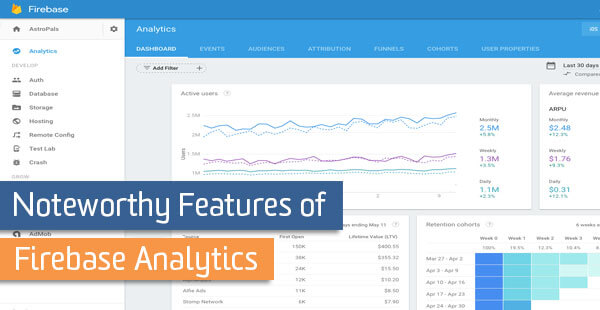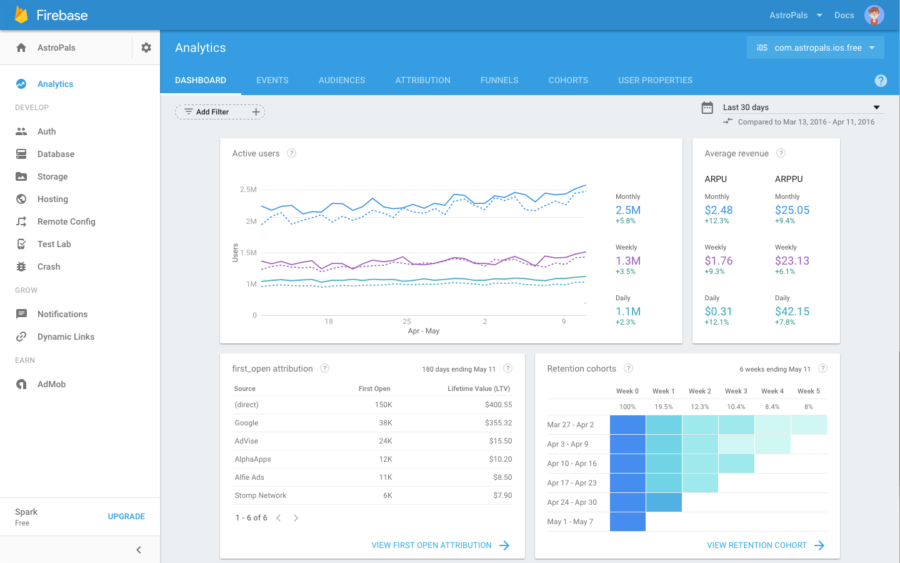Noteworthy Features Of Firebase Analytics

The Google I/O conference is always full of fun announcements, and this year is no different! One announcement that really caught our eye was about Firebase, which is now becoming a “unified app platform”. Leveraging and building on the real-time database, user authentication, and cross-device tools that Firebase already has, this announcement adds analytics, error logging, push notifications, file storage, configuration updates, and AdMob, and AdWords integration.
What is Firebase?
Before we dive into Firebase Analytics, just what is Firebase? and why haven’t we talked about it before?
Firebase was, before this announcement, a real-time database, which means when one user updated a record in the database, that update would be sent out to all connected users, be those users on a website, iOS device, or Android device. There were other features that made working with Firebase awesome from a developer’s perspective, but that was the core of their technology: keeping everyone in sync with minimal delay. Google is now building upon that core technology, and developer friendliness, to offer a whole range of other services targeted at building and running apps.
It’s interesting to see Google launch an app-specific Analytics provider, especially built into such a powerful ecosystem, in addition to building app-tracking solutions into Google Analytics. We’ll be keeping a close eye on Firebase Analytics and how the data in it can be used with Google Analytics to better understand how customers and readers interact with your digital properties.
I’ll quickly cover some of the initially interesting mentions, and then wrap up with how this might affect your current analytics setup.
Noteworthy Features of Firebase Analytics
User-Based Reporting
Readers of this blog are probably familiar with the session-based nature of Google Analytics, and some of the recent user-based reporting tools being built into it. Building on what Google has learned from Google Analytics, Firebase Analytics has been built from the ground up to be user- and event- based, not session- and page/screen view- based. This model is well-suited to how interact with an app, and, being built on Firebase, should allow for good battery performance and low loss of hits.
Audiences
This feature is particularly interesting! The analog of segments in Google Analytics, Audiences are defined by actions that users take. What makes them interesting is that they can be used through the rest of the Firebase platform, enabling audience-specific push notifications and configuration changes to be sent out without having to collate that information separately.
Audiences are also built into the crash reporting functionality of the Firebase platform, allowing cross-referencing and analysis of errors in order to see if specific devices or geographies are more prone than others.
Like Google Analytics segments, Firebase audiences can also be used for remarketing.

Integrations
We’re also excited to explore how Firebase Analytics integrates with Google Tag Manager. Similar to Google Analytics tags, as you announce events within your application, you can add Firebase Analytics tags that are triggered by them. These changes can be made even after your application has been launched.
As a side note, you will be able to have raw events pushed into BigQuery in daily batches, similar to the daily exports Analytics 360 customers have access to. These exports allow deeper dives into your data that is often possible with the API, and allows for machine learning to be used over your raw analytics data. However, this feature only appears to be available for their pay-as-you-go plan, and not the free tier.
How Should You Use Firebase with Google Analytics?
Currently there is no immediate need to modify your existing web-based Google Analytics tracking because of Firebase Analytics. However, since Firebase Analytics is User-based, it may make sense to begin storing user ids in Google Analytics, both for potential future cross referencing, but also all of the benefits that user-based reporting in Google Analytics can bring!
If you’re currently using Firebase, or even the now-old Google Cloud Messaging, it may make sense to explore how to take advantage of the updates to the Firebase platform, including Firebase Analytics. Many of the features of Firebase Analytics are similar to those found in Google Analytics, but with tighter integration into the Firebase platform. As we have more time to examine and use Firebase Analytics, we’ll be sure to post about our experiences and best-practice recommendations. However, the in-app Google Analytics SDKs (Software Development Kits) are still being supported, meaning you can transition by using both Google and Firebase Analytics if you choose to.
Firebase Analytics appears to be designed primarily for apps, and currently, not the web — in fact there is no web-based (JavaScript) SDK for Firebase Analytics, where as there are for other parts of the Firebase Platform, i.e. Messaging, Authentication, Real-Time Database, Storage, and Hosting. If you’re a web-only property, then there isn’t any need to use Firebase Analytics (however you can still take advantage of the rest of the Firebase platform!).


